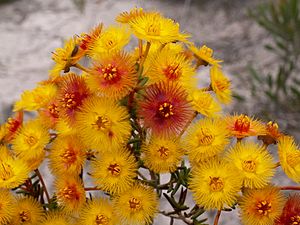Verticordia endlicheriana var. manicula facts for kids
Quick facts for kids Verticordia endlicheriana var. manicula |
|
|---|---|
 |
|
| Verticordia endlicheriana var. manicula growing near Mount Lesueur | |
| Scientific classification |
|
| Kingdom: | Plantae |
| Clade: | Tracheophytes |
| Clade: | Angiosperms |
| Clade: | Eudicots |
| Clade: | Rosids |
| Order: | Myrtales |
| Family: | Myrtaceae |
| Genus: | Verticordia |
| Species: | |
| Varietas: |
V. e. var. manicula
|
| Trinomial name | |
| Verticordia endlicheriana var. manicula A.S.George
|
|
Verticordia endlicheriana var. manicula is a beautiful flowering plant. It belongs to the myrtle family, called Myrtaceae. This plant is special because it only grows in the southwest part of Western Australia. It's usually a small, bushy plant. Its flowers are lemon-yellow and smell sweet. What's cool is that their color changes! They turn from yellow to red, and then to brown as they get older.
Contents
What Does This Plant Look Like?
Verticordia endlicheriana var. manicula is usually a small, compact shrub. It grows about 20–50 cm (8–20 in) tall. It can also spread out 20–40 cm (8–20 in) wide. Sometimes, it can even reach 1 m (3 ft) in height and width.
The leaves on its stems are long and thin, about 4–8 mm (0.2–0.3 in) long. The leaves closer to the flowers are shaped like an egg or are almost round. They are smaller, about 2–4 mm (0.08–0.2 in) long.
Its Sweet-Smelling Flowers
The flowers of this plant smell very sweet. They grow in round groups or clusters. These flower groups are on straight stalks that are 5–12 mm (0.2–0.5 in) long.
The base of the flower, called the floral cup, is wide and shaped like a top. It is 0.6–0.8 mm (0.02–0.03 in) long and has ribs. It is also smooth, meaning it has no hairs.
The sepals are like small leaves that protect the flower bud. They are lemon-yellow and about 2.8–3.0 mm (0.11–0.12 in) long. They have 6 to 8 hairy parts. These sepals change color as they get older. They turn from yellow to red, then brown, and finally almost black.
The petals are the colorful parts of the flower. They are similar in color to the sepals. They are 3.5–4 mm (0.1–0.2 in) long. The main part of each petal is 0.4–0.7 mm (0.02–0.03 in) wide. They have long, pointy parts that look a bit like fingers.
The style is a part of the flower that helps with reproduction. It is 1.7–2.1 mm (0.07–0.08 in) long and straight. It is also smooth and has no hairs. This plant usually blooms from September to November.
How It Got Its Name
The plant Verticordia endlicheriana was first officially described in 1844. This description was made by a scientist named Johannes Conrad Schauer. It was published in a book called Plantae Preissianae.
Later, in 1991, another scientist named Alex George looked closely at all the plants in the Verticordia group. He found five different types, or varieties, of Verticordia endlicheriana. One of these was the variety manicula.
The first samples of this variety were collected near Carnamah. Alex George and Elizabeth Berndt found them. The name "manicula" comes from a Latin word. It means 'little hand'. This name was chosen because the petals of the flower look a bit like tiny hands.
Where Does It Grow?
This plant usually grows in sandy soil that has gravel in it. It can also be found in gravelly loam, which is a mix of sand, silt, and clay with gravel. It often grows alongside other Verticordia plants. You can find it in areas with heath and shrubland.
Its natural home stretches from north of Mingenew down to Moore River in the south. It also grows inland towards Morawa, Goomalling, and Dowerin. These areas are part of the Avon Wheatbelt, Geraldton Sandplains, and Swan Coastal Plain regions in Western Australia.
Is It Safe?
The Western Australian Government's Department of Parks and Wildlife has checked on Verticordia endlicheriana var. manicula. They have classified it as "not threatened." This means it is not currently in danger of disappearing.
Growing It in Gardens
This Verticordia plant is very attractive. Its flowers are pretty even as they change color. They keep their changing colors for a longer time than some other types of Verticordia.
People have learned to grow this plant from cuttings. Cuttings are small pieces of the plant that can grow into new plants. It grows well when it gets lots of sunshine. Giving it a light trim now and then also helps it grow nicely.

